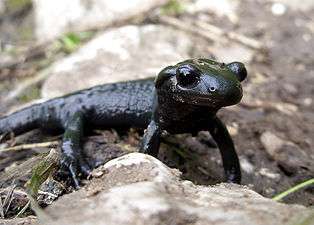Salamandroidea
The Salamandroidea are a suborder of salamanders, referred to as advanced salamanders. The members of the suborder are found worldwide except for Antarctica, sub-Saharan Africa, and Oceania. They differ from suborder Cryptobranchoidea as the angular and prearticular bones in their lower jaws are fused, and all members use internal fertilization.[2] The female is fertilized by means of a spermatophore, a sperm-containing cap placed by the male in her cloaca. The sperm is stored in spermathecae on the roof of the cloaca until it is needed at the time of oviposition.[3]
| Salamandroidea | |
|---|---|
 | |
| Alpine salamander (Salamandra atra) | |
| Scientific classification | |
| Kingdom: | Animalia |
| Phylum: | Chordata |
| Class: | Amphibia |
| Order: | Urodela |
| Suborder: | Salamandroidea Fitzinger, 1826 |
| Families | |
The earliest known salamandroid fossils are specimens of the species Beiyanerpeton jianpingensis from the Tiaojishan Formation, dated to the late Jurassic period about 157 (plus or minus 3) million years ago.[4]
References
- Anderson, J. S. (2012). "Fossils, molecules, divergence times, and the origin of Salamandroidea". Proceedings of the National Academy of Sciences. 109 (15): 5557–5558. Bibcode:2012PNAS..109.5557A. doi:10.1073/pnas.1202491109. PMC 3326514. PMID 22460794.
- Miller, Jessica J. "Caudate Families (Newts & Salamanders)". Livingunderworld.org. Archived from the original on 2007-10-16. Retrieved 2007-11-09.
- Sever, David M.; Stanley E. Trauth (April 1990). "Cloacal Anatomy of Female Salamanders of the Plethodontid Subfamily Desmognathinae (Amphibia: Urodela)". Transactions of the American Microscopical Society. 109 (2): 193–204. doi:10.2307/3226814. JSTOR 3226814.
- Gao, K.-Q.; Shubin, N.H. (2012). "Late Jurassic salamandroid from western Liaoning, China". Proceedings of the National Academy of Sciences. 109 (15): 5767–72. Bibcode:2012PNAS..109.5767G. doi:10.1073/pnas.1009828109. PMC 3326464. PMID 22411790.
